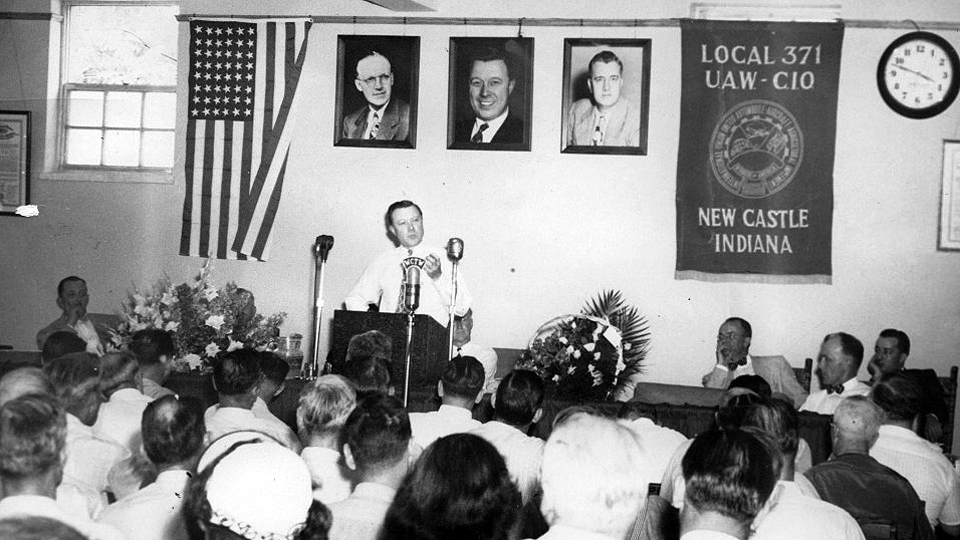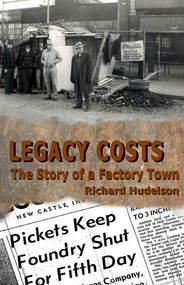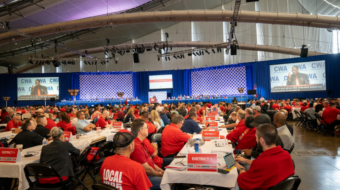
NEW CASTLE, Ind. (PAI)—After six years of research and writing Dr. Richard Hudelson had his new book, Legacy Costs: The Story Of A Factory Town, published last month by Hard Ball Press. It has a Feb. 5, 2018 release date. With Carl Ross, Hudelson co-authored By The Ore Docks: A Working People’s History Of Duluth in 2006.
New Castle, Ind., is Hudelson’s hometown. It grew into a labor town in conservative east-central Indiana. His father, Paul, worked at a Chrysler auto parts plant there which the United Auto Workers organized in 1937.
As his parents aged, Hudelson and his siblings wondered how they were to care for them. A UAW pension won in a 104-day strike in 1950 took away many of their fears.
Hudelson’s family’s history and his growing up in New Castle provide a great context for the book. As Hudelson states early on, “It is a little bit memoir and a large part labor history, combined with a vigorous defense of labor unions.”
An oft-heard complaint of labor leaders and retirees is that young members don’t know how they receive such good wages, benefits, and working conditions. Legacy Costs is an opportunity for them to learn the history of workers fighting for dignity and unions in their workplace. Here’s a chance for them to understand the big picture. The book is a great read and great educational tool.
You’ll learn about the auto industry, the UAW and union organizing, the American economy and history, capitalism, philosophy, inequality and prospects for the future for workers. It addresses the role of politics and government in the lives of workers right up to Donald Trump and Bernie Sanders. Reading the 184-page book, you come away feeling like you now get how all those forces have collided since the not-too-distant horse and buggy days and how it is they affected our work lives.
You’ll understand why Henry Ford was willing to give workers an incredible $5 a day in 1914 for piecework. His shops had 370 percent turnover. But near the end of the Great Depression workers had had enough and strikes brought in the UAW.
The Wagner Act of 1935 brought in the National Labor Relations Act that gave workers rights after employers failed in trying to establish “independent” or company-controlled unions and labor councils. The battle between the bosses and workers was on.
As a child, Hudelson turned into a union man when a violent strike at New Castle’s Perfect Circle piston ring plant found gun shots and martial law. News media blamed “outside goons” for the trouble. But Hudelson’s research of old city directories found it was the solidarity of “brothers and sisters, neighbors, relatives and friends.”
By 1946, the tide had turned away from union workers and the elections found a Republican sweep that brought the Taft-Hartley Act in 1947 that severely weakened union rights. In 1957 Indiana became the first northern “right to work” state, though it was repealed several years later—and then reinstituted recently.
Hudelson writes a great deal about right to work, which puts it in our wheel house today with 28 right to work states and business interests’ eyes on more. He writes about a Taft-Hartley clause for union authorization polls that was discarded because 97 percent of those polls found 77.5 percent of voters favoring unions.
You’ll come to better understand economic theory from Adam Smith to Milton Friedman and why free markets haven’t produced broad based prosperity. How banks have been the problem and why the Federal Reserve System of 1907 and the Glass-Steagall Act of 1933 were meant to prevent bank failures and depressions.
But government manipulating the economy with interest rates and taxes wasn’t good enough. Monied interests wanted free markets and GOP President Ronald Reagan and British Tory Prime Minister Margaret Thatcher gave it to them.
Democratic President Bill Clinton pushes and signs NAFTA and repeals Glass-Steagall and Wall Street takes over businesses it knows nothing about other than profit. And it takes over government. Shareholders are more important than workers. Private equity firms become the boss. Opponents say unions are to blame for deindustrialization but the same scenario played out in non-union areas, Hudelson writes.
In his chapter “The Way Not Taken,” Hudelson looks at the economic model used in western and northern Europe. Walter Reuther and Philip Murray [the first president of the Steel Workers Organizing Committee (SWOC), the first president of the United Steelworkers of America (USWA), and the longest-serving president of the Congress of Industrial Organizations (CIO)] had tried to get the U.S. to go in that direction after World War II but were stopped dead.
So unions come to be characterized as a special interest. Union density goes into a decades-long decline that began with the downturn of the 1980s and Reagan and Thatcher. Yet Hudelson writes: “The American people would be much more secure, much freer, and much richer if they were protected by stronger, more powerful unions.”
Throughout his new book Hudelson documents his work with an incredible array of thoughts from other writers and thinkers, which he also cites in “Sources.” But the beauty of the book is that he brings you into his arguments by talking about people from his hometown that lived the experience with him, he as a child and young man, they as working adults.
Hudelson views the 2016 presidential contest and finds hope for the future because “the ideological shell has been cracked” by both Donald Trump, in spite of his actions since, and Bernie Sanders’ popularity. As it was in the winning union organizing drives of the 1930s and battles since that were won, solidarity is the answer. It must be a solidarity that has diverse racial and ethnic inclusion, something unions do not have a good history of in their past.
Union organizing is more difficult than it has ever been, Hudelson admits. Outsourcing, subcontracting, part-time work and franchising make defining bargaining units more difficult.
Don’t be discouraged, Hudelson says. Change can come quickly and a national labor and social justice movement will be the vehicle.
“The millions of voters who supported Bernie Sanders for president and his social democratic platform have clearly shown that many of the American people no longer fall for the idea that free market capitalism will create broad based prosperity.”
Just ask the folks still in New Castle. In 2000, after a century of being the backbone of the economy, then through many ownership changes, the Chrysler plant closed. Hudelson writes, “The hammers stopped. The town was silent. The night was empty.”
Hudelson’s Legacy Costs is a masterful job of writing, a tidy, easy read that tells us how we got to where we are, like it or not. It is an important, scholarly work, well written for the rank and file.
Legacy Costs, Story of a Company Town
By Dr. Richard Hudelson
Hardball Press, 184 pages, $15.00










